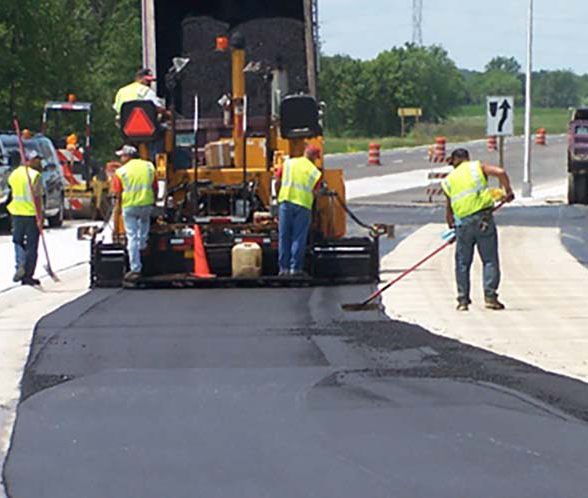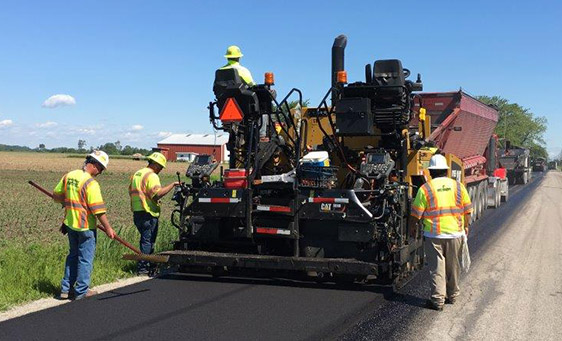Hot Mix Asphalt Paving: Elevating Commercial Parking Lot Criteria
Hot Mix Asphalt Paving: Elevating Commercial Parking Lot Criteria
Blog Article
Opening the Secrets of Hot Mix Asphalt Modern Technology
Checking out the midsts of hot mix asphalt modern technology discovers a world where precise formulations and precise processes converge to form our roads and facilities. The combination of binders, aggregates, and fillers isn't just a construction job but a calculated orchestration of durability and effectiveness. As we peer right into the complex dancing of parts, a tapestry of strength and sustainability unravels. What lies beneath this surface of asphaltic mastery, and what secrets wait to be revealed in the world of paving advancements?
Relevance of Warm Mix Asphalt
Hot Mix Asphalt plays a vital function in modern infrastructure advancement because of its resilience and cost-effectiveness. As one of the most commonly made use of leading material for roads, freeways, and car parking whole lots, Warm Mix Asphalt provides a series of benefits that add to its importance in building and construction tasks. One key benefit is its ability to endure heavy web traffic tons and rough weather, offering a long-lasting and reliable surface for transport networks. In Addition, Hot Mix Asphalt is economical in both first building and construction and long-lasting maintenance, making it a favored selection for numerous framework projects.
The resilience of Warm Mix Asphalt stems from its composition, which consists of accumulations, binder, and filler materials that are meticulously selected and mixed to meet specific efficiency needs. Overall, the value of Warm Mix Asphalt in framework growth can not be downplayed, as it continues to be a cornerstone of contemporary construction methods.
Components of Asphalt Mixes
The composition of asphalt blends includes carefully selected accumulations, binder, and filler materials that are critical for attaining specific efficiency requirements. Accumulations are the key element of asphalt blends, offering stamina and stability. These aggregates can be all-natural, such as crushed rock or crushed stone, or artificial, like recycled products from old sidewalks. The binder, generally asphalt or asphalt concrete, holds the accumulations together and gives flexibility and durability to the mix. The choice of the binder is vital as it directly affects the mix's performance in different climate conditions. Fillers, such as hydrated lime or Portland concrete, are used to improve the mix's workability and aging resistance. Angled Parking.
The mix and percentage of these components play a significant duty in establishing the quality and efficiency of the asphalt mix. Designers carefully develop the mix to fulfill details demands, taking into consideration factors like website traffic quantity, environment conditions, and pavement life expectancy. Correct choice and balancing of aggregates, binder, and fillers are vital for creating resilient, lasting asphalt pavements.
Combining and Production Techniques

Once the accumulations are chosen, the binder, typically asphalt concrete, is contributed to bind the materials with each other. The binder's top quality and quantity significantly impact the mix's versatility, strength, and resistance to environmental factors. Additionally, fillers like hydrated lime or Rose city concrete might be incorporated to boost particular qualities of the asphalt mix, such as its workability or dampness resistance.
Throughout production, the aggregates and binder are warmed, generally in between 250-325 ° F(121-163 ° C ), to facilitate blending and ensure appropriate blog here covering of the accumulations. The mixing procedure needs to be thorough to accomplish an uniform mixture that promotes the wanted performance qualities of the asphalt. Various techniques, such as set blending or drum mixing, are employed to accomplish high-quality and constant asphalt mixes for building projects.
Elements Influencing Asphalt Efficiency
Factors affecting asphalt performance incorporate a variety of variables that influence the resilience, durability, and overall high quality of asphalt pavements. One vital aspect is the quality of products made use additional hints of in the asphalt mix.
Style considerations, such as sidewalk thickness and drain, are essential in making certain the long-term performance of the asphalt sidewalk. By meticulously taking into consideration these factors, engineers and service providers can maximize asphalt performance and enhance the solution life of pavements.
Sustainable Practices in Asphalt Innovation

WMA enables for the production and positioning of asphalt mixes at lower temperature levels contrasted to standard hot-mix asphalt, resulting in decreased energy usage and greenhouse gas exhausts. The usage of porous asphalt mixes can aid minimize stormwater drainage concerns by permitting water to penetrate via the pavement and right into the ground, advertising all-natural water filtration and recharge processes.
Final Thought
In verdict, warm try this website mix asphalt technology plays a critical role in modern-day facilities growth due to its sturdiness and cost-effectiveness. By carefully stabilizing parts, using appropriate blending techniques, and taking into consideration numerous aspects, designers can develop top notch asphalt blends that stand up to hefty traffic loads and harsh weather condition conditions. Accepting sustainable techniques, such as utilizing warm-mix technologies and recycled products, better improves the ecological friendliness of asphalt innovation.
Blending and manufacturing strategies in hot mix asphalt technology involve the specific mix and handling of aggregates, binder, and fillers to produce a high-performance and durable asphalt mix.Aspects influencing asphalt efficiency incorporate an array of variables that impact the longevity, durability, and general top quality of asphalt pavements. Sustainable techniques in asphalt innovation incorporate various campaigns intended at reducing the ecological effect of asphalt production and paving procedures. By incorporating recovered asphalt pavement (RAP) and recycled asphalt tiles (RAS) into brand-new asphalt blends, the industry can dramatically minimize the intake of raw materials and power, while likewise reducing garbage dump waste.
WMA permits for the manufacturing and positioning of asphalt blends at reduced temperature levels contrasted to typical hot-mix asphalt, resulting in decreased power intake and greenhouse gas emissions.
Report this page